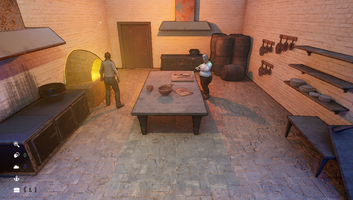So what is this game anyway??



From the first playtesters of the game one thing that’s come back a few times is “it feels like Monkey Island!” which is both terribly flattering and terribly terrifying. The flattering part should be obvious, Monkey Island is unquestionably a classic piece of media. The terrifying part might need a touch more explanation…
Let’s get the obvious out of the way, that’s a lot of pressure.
Less obvious is that even though my game shares some basic mechanics with the classic point and click adventure genre it doesn’t neatly fit within it. There is an inventory, but not really puzzles in the traditional sense. You talk to the characters, but there’s no way to “fail” a conversation, just different paths and reactions. Traditional adventure games place blocks on progress based around (often) esoteric logic puzzles, and whilst solving these gives a sense of satisfaction and it could be argued are what makes them “games”, I found as my years advance I have less and less patience for them. I love the idea of P&C games now more than the reality. I want to explore the environments, discover the story, and if the game makes me feel like i’ve achieved something because of my choices then all the better.
So how to build this into the design of a game? How to give players the satisfaction of agency, of their actions and choices having an impact, without forcing them into ill defined conflict with the author?
I’ve come up with a few ways around this, pulling inspiration from directions one might not necessarily consider relevant to the genre.
If you had to name a game which has had enormous influence on the industry in the last decade chances are that the Souls series would be pretty high up that list. Whilst sold as tough as nails action games (which they are) fans will more than likely talk your ear off about the lore, about how they discovered it, and how they pieced it together. Item descriptions, short obscure conversations, ineffable NPC’s with their own storylines, environment design, these things together weave a surprisingly in depth tapestry that holds up the unforgiving action and makes you want explore as much as possible. So how is that relevant to a game with no action at all?
I mentioned the inventory, in my game inventory items are like Dark Souls NPC’s, they have their own storylines. Some are short and sweet (or very, very bitter), and some span almost the entire length of the game. Simply having that item in your inventory (or not!) at the right time can kick off a sequence of events, a sub plot, that fills out the characters and world around you. Some have multiple stages, combinations, and outcomes. It would be impossible to see them all on one playthrough.
Now things start to get complicated…
My game is one story. There are not multiple wildly different endings. There is no “good” or “bad” outcome. What i’m concentrating on is giving each player their own version of the story, the version they want, the version they choose. This also gives me the opportunity to experiment with each scene without breaking the overall structure. I want to give the players feedback on what they’ve done, but never to punish arbitrarily. "Well now how is that going to work??" That's a very good question, and one that I'm constantly asking myself when i'm writing the dialogue and designing each interaction, ultimately this will be what makes or breaks the entire project.
No pressure then.
Files
Get The Fleeting Tide
The Fleeting Tide
A darkly comic murder mystery adventure game.
| Status | Prototype |
| Author | morphun_games |
| Genre | Adventure, Visual Novel |
| Tags | Detective, Mystery, Narrative, Point & Click, Story Rich |
More posts
- The Dia(b)logueOct 22, 2020
Leave a comment
Log in with itch.io to leave a comment.